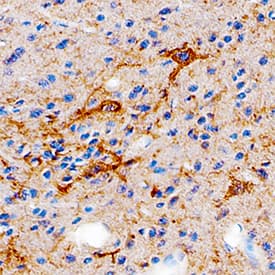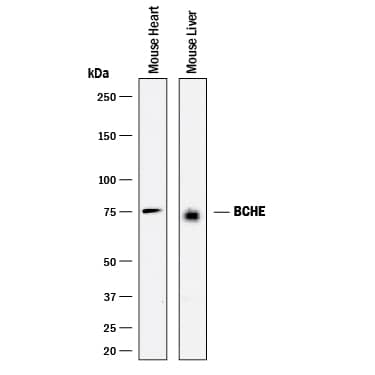Mouse/Rat Butyrylcholinesterase/BCHE Antibody
R&D Systems, part of Bio-Techne | Catalog # AF9024

Key Product Details
Species Reactivity
Validated:
Cited:
Applications
Validated:
Cited:
Label
Antibody Source
Product Specifications
Immunogen
His28-Leu603
Accession # AAH99977
Specificity
Clonality
Host
Isotype
Scientific Data Images for Mouse/Rat Butyrylcholinesterase/BCHE Antibody
Detection of Mouse Butyrylcholinesterase/BCHE by Western Blot.
Western blot shows lysates of mouse heart tissue and mouse liver tissue. PVDF membrane was probed with 1 µg/mL of Goat Anti-Mouse/Rat Butyrylcholinesterase/BCHE Polyclonal Antibody (Catalog # AF9024) followed by HRP-conjugated Anti-Goat IgG Secondary Antibody (Catalog # HAF017). A specific band was detected for Butyrylcholinesterase/BCHE at approximately 75 kDa (as indicated). This experiment was conducted under reducing conditions and using Immunoblot Buffer Group 1.Butyrylcholinesterase/BCHE in Mouse Brain.
Butyrylcholinesterase/BCHE was detected in perfusion fixed frozen sections of mouse brain using Goat Anti-Mouse/Rat Butyrylcholinesterase/BCHE Antigen Affinity-purified Polyclonal Antibody (Catalog # AF9024) at 5 µg/mL overnight at 4 °C. Tissue was stained using the Anti-Goat HRP-DAB Cell & Tissue Staining Kit (brown; Catalog # CTS008) and counterstained with hematoxylin (blue). Specific staining was localized to glial cells. View our protocol for Chromogenic IHC Staining of Frozen Tissue Sections.Applications for Mouse/Rat Butyrylcholinesterase/BCHE Antibody
Immunohistochemistry
Sample: Perfusion fixed frozen sections of mouse brain
Western Blot
Sample: Mouse heart tissue and mouse liver tissue
Formulation, Preparation, and Storage
Purification
Reconstitution
Formulation
Shipping
Stability & Storage
- 12 months from date of receipt, -20 to -70 °C as supplied.
- 1 month, 2 to 8 °C under sterile conditions after reconstitution.
- 6 months, -20 to -70 °C under sterile conditions after reconstitution.
Background: Butyrylcholinesterase/BCHE
Butyrylcholinesterase (BCHE) is a major acetylcholine hydrolyzing enzyme in the circulation (1). Although it is present in significant amounts (~3 mg/L) in human plasma, no endogenous physiological substrate has been described for this enzyme. It can degrade a large number of ester-containing compounds in addition to acylcholines. Thus, it is likely to play significant pharmacological and toxicological roles. It is thought to be involved in the pathological process of Alzheimer's disease (AD) by depleting acetylcholine. In contrast to ACHE, it attenuates amyloid fibril formation in vitro (2). BCHE inhibitors have been used to delay symptoms of AD patients by virtue of their ability to enhance acetylcholine availability (3). Its involvement in a cholinergic anti-inflammatory pathway connect BCHE and ACHE with a possible marker of low-grade systemic inflammation observed in Type-2 diabetes, obesity, hypertension, coronary heart disease, and AD (4). BCHE can exist in monomeric and multimeric forms (1).
References
- Darvesh, S. et al. (2003) Nat. Rev. Neuroscience 4:131.
- Diamant, S. et al. (2006) Proc. Natl. Acad. Sci. USA 103:8628.
- Campbell, V. A. and Gowran, A. (2007) Br. J. Pharm. 152:655.
- Das, U. N. (2007) Med Sci Monit. 13:RA214.
Alternate Names
Gene Symbol
UniProt
Additional Butyrylcholinesterase/BCHE Products
Product Documents for Mouse/Rat Butyrylcholinesterase/BCHE Antibody
Product Specific Notices for Mouse/Rat Butyrylcholinesterase/BCHE Antibody
For research use only

